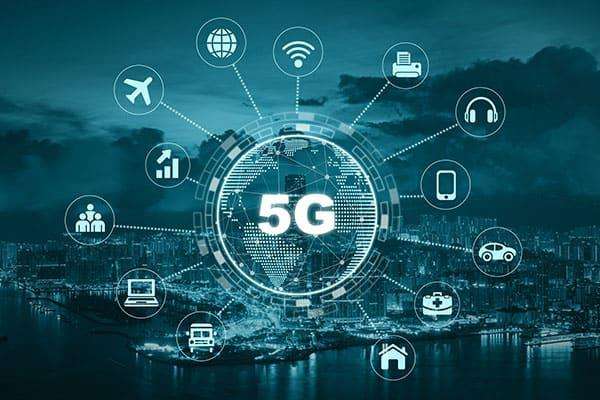5G Technology


4G has not completed its revolution yet but the world has widened the next generation activity where action is taken in the form of 5G (fifth generation). In 2013, the project of 5G has been in the way to contribute to the advance technology in the world. 5G will be faster than 4G network resulting in high speed data transfer i.e., 1TB data in seconds. 5G will have more features like MIMO; Cloud computing, IoT and etc.
5G will have more voice clarity which you have never experienced before. There will be artificial intelligent in 5G in future by using this generation. In 5G we will use wwww where there is no limit of wireless network. Streaming video will be in HD form where there will be no combination of signals. 5G technology will be available for use; more in 2018 to 2020. Fig 4 shows how the world can be connected by 5G network and how it brings all the previous generation into it and the electronic manufactured devices are connected to the network
1. mimo:
The next level of antenna technology has arisen in the form of MIMO (multiple input, multiple output). MIMO is the advanced technology for wireless communication between antennas. This technology will use multiple antennas at the mobile station (transmitter) and the base station (receiver) [10]. The communication circuits are coupled to minimize errors and optimize data speed for antennas at each end. By using a single antenna at the source and destination which creates a problem in multipath effects. In wireless internet, this can cause an increase in the number of errors and a decrease in data speed.
This multipath effect can be overcome by the use of two or more antennas simultaneously transmitting multiple signals at the source and destination. The application of MIMO technology will be in wireless local area networks (WLAN) for mobile communication, and in digital television (DTV). Fig.5 shows how MIMO multiplexing is working between two antennas (transmitter and receiver) using radio propagation channels. MIMO is one of the many forms of smart antenna technology; others are SIMO (Single Input, Single Output) and MISO (Multiple Input, Multiple Output). Electronic manufactured devices are connected to the network.
2. Cloud Computing:
Further 5G will require storing a large amount of data and result in some traffic, cloud computing is used to overcome this problem. Cloud computing will provide an extra-common backend for any application on mobile devices to access some of the services such as, software, storage, computing power and etc. Cloud computing is mainly used for user in the cloud, can access the cloud service from any geographical location from any device. Cloud computing used now should be more flexible and easy when using the advanced generation i.e., 5G.
The data rate of the mobile will be measured in multiple of GBPs. More free space will be available for the user by using this technology. Cloud computing will free the user to carry documents, apps, services with them without having to go anywhere.
3. Millimeter Wave Technology:
Millimeter wave technology is widely used in sectors such as mobile and telecom, consumer and commercial, healthcare, and others. Due to the small wavelength, small antennas can achieve a very tight beam width, which makes re-using frequencies easier, and network design and interference management much easier. Millimeter wave communication is expected to be a key part of 5G mobile technology to provide multi-gigabit communication services such as high definition television (HDTV), ultra-high definition video (UHDV), and so on. The focus was placed in upcoming bandwidths such as 28 GHz band, 38 GHz band, 60 GHz band, and E-band (71–76 GHz and 81–86 GHz). And transparency or pass through any object like concrete, glasses, wood and so on.
4. Device to Device:
D2D (device-to-device) communication which enables direct communication between nearby mobiles is an exciting and innovative feature of 5G cellular networks. D2D communication refers to a radio technology that enables devices to communicate with each other directly, without routing data paths through the network infrastructure. While traditional cellular architectures involve connections from base stations to user devices, 5G systems may well rely on a two-tier architecture, consisting of a macro cell tier for base station to device communications, and a second device tier for device to device (D2D) communications. Device-to-device (D2D) communications is another technology to be used in 5G that will rely on a two-tier architecture. D2D may also allow users to experience benefits in terms of reduced communication latency, increased data rates and reduced energy consumption.
5. Internet of Things:
Internet of Things (IoT) is the type of technology that will be used in 5G. IoT will be used to connect all devices by the internet through sensors. The use of IoT leads to the creation of smart cities in the country. The applications of IoT are as follows: Consumer electronics, Automotive and transportation, Energy and utilities, Factory and commercial building, and etc. IoT will have machine to machine communication due to enhancing the devices used by humans to improve the handling of the device in an easy way. In the future all the devices will be connected to the internet and they can also control through the internet. The use of internet will be on a huge level due to its need in devices for wireless communication.
IoT will be human to machine communication in which machines will be controlled by humans through wire free signals. This technology will provide time saving for human such as going to the shops. IoT even provides wireless communication for our home application to provide more flexibility to the home makers to make the work easier. This technology will make human feel better to handle or reach from one place. In the same way communication must be compatible and security for users otherwise it will be serious reason for customer who uses this technology.
6. 5G Technology Requirement:
As the technology is booming, many companies had started their work on 5G, they had introduced some requirements. They are as below: • It needs 1-15Gbps connection to the end points in the field. Energy usage will be reduced by 90%
7. Features of 5G Technology:
Some of the main features of 5G technologies are below: • Faster internet speed. Much higher capacity. • Low power consumption and low latency. • Greater network flexibility. • Support Virtual Private Network. • Multiple devices can connect by wireless. • Uploading and downloading speed will be a peak. • Traffic statistics will be more accurate. • It will use supervision device for faster action.
Conclusion
In this article, we conclude that 5G network is very fast in data transfer between two devices and reliable. All the technology used in this paper will make believe that wireless communication will be powerful tool in 5G mobile technology. Future 5G will bring unexpected way of communication. 5G will change the lifestyle of human in upcoming centuries.
Read Also:
- A Review Paper On 5G Wireless Technology
- Wireless Technology In Networks
- Overview Of Wi-Fi Technology
- Negative Impacts Of Science And Technology
- Benefits Of Science And Technology
- Towards 6G: Future Communication Technology
- 6G Technology
Recent Posts
Itel Launched Alpha Pro Smartwatch
Itel has launched Alpha Pro smartwatch with powerful sports activities sports activities sports activities modes,…
How To Record Whatsapp Calls? Quickly Identify Its Smooth Way
How to record WhatsApp calls: WhatsApp does not have any built in recording function. This…
Reliance Power’s Share Rose 16% Today:₹ Reached A 52-Week High Of 60.50, In One Year The Company’s Share Returned 135%
Shares of Anil Ambani's company Reliance Power rose nearly 16% today (May 30) on Friday.…
Now You Can File ITR: Income Tax Department Issued ITR-1 And ITR-4 Forms, Last Date 15 September
Income Tax Department has made available Excel Utility for ITR-1 and 4 for Financial Year…
Investing In Senior Citizen Saving Scheme Can Prove Helpful In Old Age: You Can Earn Rs 20,500 Every Month, Know Its Complete Mathematics
By investing a lump sum amount in the Post Office Senior Citizen Saving Scheme Account…
Soon You Will Be Able To Withdraw PF Money From UPI-ATM
The new facility will be available from June, with this you will still be able…


